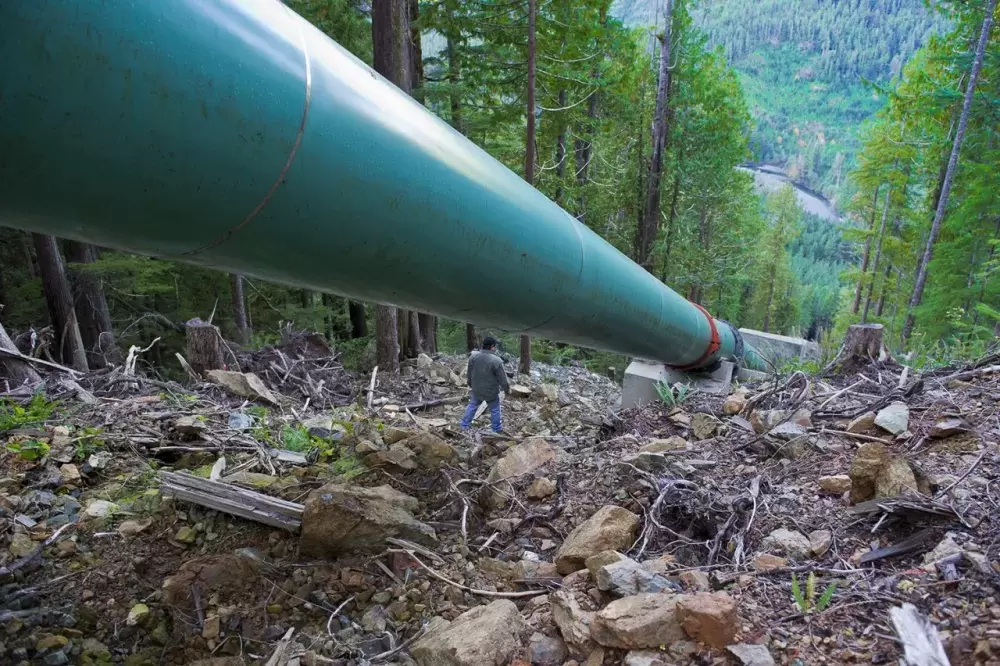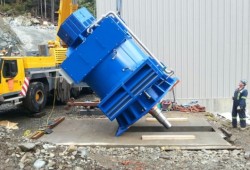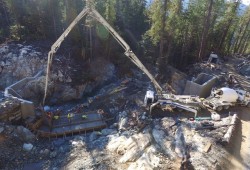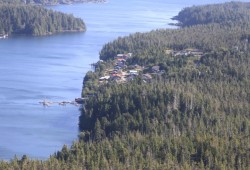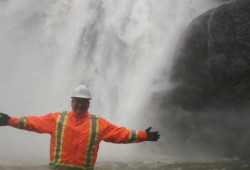Whether we’re working, relaxing at home or sleeping, a reality of modern life is the continual dependence on electricity. As things like household lights, computers, appliances and baseboard heaters are an integral part of our day-to-day existence, it’s easy to lose site of the fact that – for the vast majority of British Columbia’s residents – these essential items are powered by a massive network of 18,000 kilometres of transmission lines and 55,000 kilometres of distribution cables stretching across the province in a shared web.
But where electricity will come from in the future continues to be debated, as utilities, governments and First Nations weigh the impacts of power generation. With 95 per-cent of B.C.’s electricity being generated by water, are large-scale dams, such as the multi-billion-dollar Site C project on the Peace River, the best answer? Or should the province be looking more into micro hydro initiatives, like those in various stages of development by First Nations on Vancouver Island?
Despite its prevalence of streams, rivers and lakes, just 35 per cent of electricity used on Vancouver Island is generated there, according to BC Hydro. The rest of the power comes from B.C.’s mainland, where the power grid mostly relies on large-scale hydroelectric dams on the Columbia and Peace rivers.
Nearly two decades ago the Hupacasath First Nation were looking for a different approach to power generation when BC Hydro was proposing to build a large plant in Port Alberni.
“We were opposed to it, it lets off a fine particulate matter that gets on trees and plants, things don’t grow properly and we were worried about air quality,” recalled Judith Sayers, who was the Hupacasath’s chief councillor at the time. “We asked ourselves, ‘How can we be part of the solution? Why are we always saying no?’ We started our research.”
The best solution in Hupacasath territory appeared to be run-of-the river projects, which divert part of a stream into a large pipe, or pen stock. The pen stock pipe descends, naturally increasing the velocity of the water with the drop in elevation. This generates power when the water finally reaches a turbine before it is released back into the stream.
“At the top of it you just need to use pipes that are fairly thin, but as you go further down they have to get bigger and thicker until they’re actually steel as it comes down that last hill into the powerhouse because it’s gathered so much pressure,” explained Sayers. “That’s one of the biggest costs in a run-of-the-river project is the actual buying of that pen stock.”
China Creek was selected from 10 possible-run-of-the-river sites. The $14-million initiative began operating in December 2005, with 72.5 per cent of the endeavor owned by the Hupacasath. Other partners in the venture include Synex Energy resources, the Ucluelet First Nation and the City of Port Alberni, who own 12.5, 10 and five per cent of the project respectively.
With the generating capacity of 6.5 megawatts at peak streamflow, during heavy rainfall in the winter China Creek can produce enough electricity for 6,000 homes, comparable to the total number residences within the City of Port Alberni. Run-of-the-river projects are designed to divert water from a stream without disturbing fish and other aquatic life, so power generation stops when stream volume reaches the minimum level. For China Creek this normally means a down period between mid-July and mid-October.
Through a 20-year purchase agreement with BC Hydro, China Creek generates revenue for its owners by selling power into the electricity grid, as well as creating jobs for the First Nation of 300 members.
“We’ve created two full-time jobs out there,” said Sayers, adding that additional help is sometimes needed. “We employ people in the fall to try and rake up leaves so that it doesn’t get sucked into the intake and clog it up.”
Further west on Vancouver Island towards Ucluelet, the Tla-o-qui-aht First Nation is operating two run-of-the river projects on Canoe and Haa-ak-suuk creeks. The projects are designed to harness the west coast’s combination of steep terrain and heavy rainfall, said Saya Masso, the Tla-o-qui-aht’s natural resource manager.
“The pen stock starts up at the high parts of the mountain,” he described. “The water is passing up between two rocks that are six feet apart, you’re putting that into a tube, racing it down a hill and turning it into a little laser beam to spin the jets.”
As is the case with China Creek, the Tla-o-qui-aht’s micro-hydro projects are designed to avoid disturbing fish and other aquatic life with the placement of the pen stock and generating plant.
“The water is still clean after we generate electricity; it doesn’t impact our fisheries,” said Masso. “We’ve planned and done all of the hydrology to look at projects that are at a waterfall where fish cannot go above.”
With a generating capacity of six megawatts each, the micro-hydro plants began operating in 2010 and 2014 respectively, with 40-year agreements to sell the power to BC Hydro. While the Tlo-a-qui-aht are in the early stages of repaying debt from starting the multi-million-dollar projects, the stream of hydro revenue has proven to be an appropriate alternative to a proposal from Imperial Metals to explore gold mining in the nation’s hahoulthee.
“A 100 years of benefits in jobs, versus 12 years of boom and bust mining,” said Masso. “We’re participating in economic development in a sustainable manner in our territory. We’re the leader in it, and it’s not owned by an outside corporation, so the benefits will stay in our nation.”
“[It] feeds a cash flow for us to do other employment drivers like campgrounds, our tribal park outpost, guardian programs, trail-building programs, environmental monitoring or using it to support the guardian program for restoration and stream keeping,” he added.
The Tla-o-qui-aht will complete construction of another run-of-the river project this summer, a four- megawatt plant on Winchie Creek. On average, the three stations will generate enough electricity annually to power approximately 5,500 homes, far more than the total number of residences in Tofino, Ucluelet and other nearby communities on Vancouver Island’s west coast.
The First Nation is working with the Barkley Project Group to develop and operate the run-of-the river facilities, a firm with a long list of First Nations partnerships on the West Coast. The company’s president Iain Cuthbert believes that the Tla-o-qui-aht have illustrated what can be done by a First Nation generating its own power.
“On a day like today they’re powering all of Tofino and Ucluelet and those surrounding areas,” he said on a rainy April afternoon. “It’s one of the only areas of resource development that you can get into where you can accrue benefits from a natural resource without having to deplete or degrade it. You’re just basically recycling rainfall.”
The Tla-o-qui-aht plan to develop four more projects in the Tofino and Tranquil watersheds. While the First Nation is confident B.C.’s NDP government will appreciate the benefits of small-scale run-of-the river operations, it’s become clear that the province’s focus in the future will be on large-scale projects. While in opposition the NDP were critical of Christy Clark’s Liberals for pushing the $9-billion Site C dam into construction. But while over 1,700 workers were on the site in December, with his party now in power Premier John Horgan announced that the province’s best option is to proceed with Site C.
Located on the Peace River downstream from the W.A.C. Bennett and Peace Canyon dams, Site C will create a reservoir covering 9,330 hectares for a capacity of 1,100 megawatts, making it the fourth largest electricity producer in B.C.
Sayers, who is now president of the Nuu-chah-nulth Tribal Council, is concerned this will leave little opportunity for First Nations to develop their own small-scale projects as competition for BC Hydro’s purchase agreements intensifies.
“With the number of First Nations that want to build projects, it’s going to be fierce,” she said. “This government should have killed Site C, that’s all there is to it.”
BC Hydro has responded to criticism by forecasting a power deficit if Site C is not built.
“As extensive as BC Hydro's electricity supply is, it will not be enough to meet B.C.'s long-term electricity needs,” stated the provincial utility on its website. “BC Hydro forecasts that B.C.'s electricity needs will grow by almost 40 per cent over the next 20 years, driven by a projected population increase of more than one million residents and economic expansion. An emerging liquefied natural gas sector and growth in the use of electric vehicles would further increase demand in the future.”
Sayers expects a different scenario.
“They are going to have too much energy,” she said, foreseeing struggles in where to export the surplus power. “They are looking at trying to find buyers…I don’t think that’s a possibility. The US will probably take some, but I don’t think people in California will take power from any big dams. They don’t consider that clean energy.”
For the time being it appears that more micro-hydro projects are coming to Nuu-chah-nulth territories on Vancouver Island. The Huu-ay-aht First Nations have been developing a five-megawatt project on the Sarita River, which would sell power into the grid. Access roads have been built, but another two years of construction are needed for the plant to operate. The finalization of an electricity purchase agreement with BC Hydro is expected in April.
The Barkley Project Group is also managing the Sarita River Hydropower Project. Cuthbert said the Huu-ay-aht have progressed through many years of environmental assessments, community consultations, as well as the necessary applications to the provincial and federal governments to secure an EPA.
“That gives Huu-ay-aht the certainty that they have a market to sell all of the electricity that they generate under a 40-year contract with BC Hydro under what’s called the Standing Offer Program,” he said.
The project could also serve as a back-up supply to the Huu-ay-aht village of Anacla, which had power outages last winter when storms affected the line from Port Alberni.
“That’s something that’s being explored to see if it’s technically viable,” said Cuthbert. “BC Hydro made a commitment to study that to see whether or not the Sarita River project can provide power exclusively to Bamfield and Anacla if there’s a fault in the line.”
Further north on Vancouver Island’s west coast, the Barkley Project Group is working with another remote First Nation community that isn’t even connected to the hydro grid. Each year the Hesquiaht First Nation spends at least half million dollars to have diesel shipped to power generators for its 50-some residents in Hot Springs Cove, located north of Tofino. This year construction began on a project to harness streamflow from the nearby Ahtaapq Creek, a 250-kilowatt facility that is designed to replace 97 per cent of the energy currently supplied to the community by diesel. With an estimated cost of over $10 million, the project is being funded by the federal government as part of a widespread initiative to make Canada’s 175 off-the-grid communities less dependent on diesel.
The access road from the community to the project site is currently being built.
“This will take three months, then the next step will be working at the site,” said Richard Lucas, chief councillor of the Hesquiaht First Nation. “We had to [take] three or four little water tributaries and give them names.”
After 11 months of site construction Ahtaapq Creek is expected to be generating power by April 2019, with two to three positions needed for ongoing operations.
For Sayers, it’s another example of improving efficiency by a community harnessing its nearby power, rather than relying on transmission from a distant source.
“The longer you have to put electricity on transmission lines, the more you lose,” she said. “Making every area in the province independent of the grid is beneficial. The jobs that are created is huge, as well as keeping money in the area.”
BC Hydro has called run-of-the-river and other smaller renewable sources of power undependable during times of peak demand, making them “not a cost-effective alternative to Site C, as they would require additional capacity resources be built for backup.” But the Tla-o-qui-aht are stressing that part of the value in harnessing the power in streams is that generation peaks during the west coast’s rainy winters, when electricity usage is highest across B.C.
“We are trying to deliver winter power, while the rest of the BC Hydro energy grid is accumulating snowpack for their spring melt-off power,” said Masso. “We are an anomaly of trying to provide winter power, the exact type of energy power that [BC] Hydro needs.”

